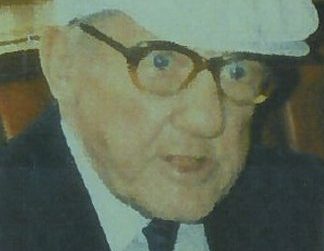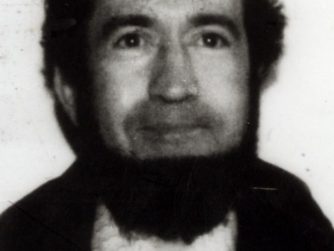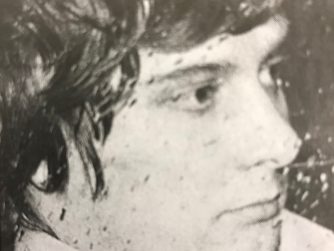
It was to be December 17th 1996 before Mardi Gra surfaced again, and once again with a new tactic. A letter arrived at the Daily Mail offices containing a threat that unless Sainsbury’s acknowledged that he was back and paid the ransom he demanded, Mardi Gra would begin shooting its customers with an improvised crossbow device, an example of which he detailed in the letter. It would be mounted inside a large, reinforced Sainsbury’s bag and would fire through a prepared slit in the side after being activated by a fishing line attached to the trigger. This could be operated in a crowd of people, and Mardi Gra himself could escape with ease and anonymity. There was also a photograph of a lone female shopper enclosed, ominously marked with a label marked “targeted for action”. Police believed that this threat was a bluff however, as it would require Mardi Gra to operate in person at the moment of impact, a world away from the remoteness and safety of his distance and anonymity. As a result, his bluff was called and under request from SO13, the Daily Mail did not publish the photograph as requested. A further letter followed on January 7th 1997, which now contained two photographs, again of lone female shoppers – and a home-made crossbow bolt. This demand was again ignored – and following this, Mardi Gra again disappeared into the woodwork.
This was to be his longest gap – and also the precursor for his deadliest, but thankfully final phase.
While Mardi Gra had gone to ground, Operation Heath continued in earnest, and the Metropolitan Police utilised two different types of profile in hunting for Mardi Gra. One was a psychological profile delivered by Professor Bill Tafoya, who had been the lead profiler of the FBI’s Unabomber Task Force. Tafoya was to produce a profile that was to prove ultimately very close to the mark. He wrote that the reason for targeting Barclays and Sainsbury’s could have been as simple a reason as having been insulted by a member of staff, buying soiled goods, or having a credit card application refused. He claimed that the bomber would be male, middle-aged, of average intelligence, would have a boring or menial job and would be known as someone who was known to harbour grudges. He would feel “undervalued”, would live in London and would be a loner, although possibly married in the past. Examining the devices sent by Mardi Gra, and in what was a deliberate ploy to draw out a response from him by insulting him, Tafoya suggested that the devices were “unsophisticated”, highlighting his constant use of readily available ammunition and everyday items, and that “if Mardi Gra had the intellectual capacity to make more complex bombs, he would have done so by now”.
The other profile utilised by the Met, and again one that was to prove accurate, was a geographical one. Using the maxim that a criminal strikes within defined routines, or to put it more simply, where you live defines the parameters in which you act, the details of Mardi Gra’s existing 24 attacks were entered into a US prototype profiling software called Orion. It already was clear to investigators that there was an existing clear pattern of attacks, which the majority occurred in the West and the South-East of London. The profile created by the Orion software highlighted a peak over the W4 district of the city, specifically Chiswick. This again was to later prove uncannily accurate. But frustratingly, although it was a focal point, it did not serve to narrow down the field of suspects except to confirm to police that Mardi Gra was local to the West London area.
So the hunt continued – and then Mardi Gra returned after 11 months.
On Saturday November 15th 1997, three branches of Sainsbury’s were targeted in a return to Mardi Gra’s preferred method of device: the video case explosive. Copies of the video case of the film “GRAND CANYON” were left in abandoned bags of groceries in the Sainsbury’s stores in Greenford, West Ealing and South Ruislip. All three were devices of the shotgun cartridge type, designed to fire pellets into the face or body of the person opening them. But, as investigators were becoming used to seeing from Mardi Gra, there were modifications. The barrels had been reinforced and angled, the shot was better packed, and the method of disposal showed a newer, ingenious twist: Mardi Gra had got customers to take the devices into the stores at random. Each video had attached a blue sticker with the following message:

Perhaps realising that by physically leaving items instead of posting them out, Mardi Gra ran the risk of being captured on CCTV. By someone else taking the device into its intended target, Mardi Gra was ensuring that as much distance as possible between capture and himself was placed.
And then Mardi Gra followed with a double attack just ten days later, in yet ANOTHER refinement of his MO. Again the video cassette devices were used, but this time the message on the stickers contained a red dot, with a small sticker claiming:
ANY VIDEO BEARING A RED DOT HAS BEEN CLEARED BY SAINSBURY’S SECURITY STAFF
The first was found on the driveway of an empty house in Chislehurst, Kent, about 500 yards from the local Sainsbury’s. It had exploded itself, and chillingly, had been left opposite a primary school. An hour later, a customer to Sainsbury’s Burnt Ash store in Lee Green handed in a device that had been left outside in a bag of shopping. SO13 quickly arrived and disarmed the device. Eleven days later, on 06 December 1997, a 73-year-old lady named Joan Kane who had caught a bus outside the Sainsbury’s in West Ealing arrived home with her shopping to discover that she had somehow picked up an extra shopping bag. She fished out a Mardi Gra device and began to innocently examine it, and was only saved with the timely intervention of a visiting neighbour, who recognised the danger instantly. Sadly, just 10 weeks later, Joan died very suddenly from an aggressive form of leukaemia. Her last weeks were spent in fear and suffering what must have been horrific flashbacks of how close she had come to serious injury, or even death. Her peace of mind was destroyed and she became a shell of her former self due to her finding the device, a fact that her doctors were in no doubt accelerated her condition.
A few days before Christmas 1997, a change in police strategy had been decided upon, and a decision had been made to pay Mardi Gra, hoping to catch him in the act of receiving his money. Working on the theory that Mardi Gra would next strike again within his chosen ground of West or South-east London, a decision was made to blanket every Sainsbury’s store in each area with covert surveillance, and hope that they would get lucky and catch him planting a device. It was a mammoth task and one that seemed to have a slim chance of succeeding, but hunting him was getting nowhere. They opted to post communication agreeing to his latest demands, which had been £10,000 per day unlimited. Promotional cards, as of the type Mardi Gra had first demanded in his initial communication three years before, were to be made and given away with Exchange & Mart classified advertising magazine. Then, using a PIN number known only to Mardi Gra, a maximum of ten could be used as cash cards. On December 27th 1997, the following message from police appeared in the Daily Telegraph personal column:
Work will be completed and ready for London circulation on Thursday 26th March 1998. This is the earliest possible date. Hope it meets your schedule. G
Mardi Gra ignored this, but responded by planting bombs in Sainsbury’s Chiswick High Road on January 16th 1998, followed by a device left at the beginning of February at what transpired later to have been the same bus stop that Joan Kane had picked up her surplus shopping bag. The former was found and deactivated, the latter exploded, albeit luckily before it had been collected by anyone. A week later, a member of the public who had found a bag of shopping left by a cash point nearby to a Sainsbury’s in Forest Hill, south-east London, had a lucky escape when the bag he had placed onto the passenger seat of his car suddenly detonated as he was driving down the A2. This was followed on March 4th 1998 by another “shotgun” type device that injured a 17-year-old shop worker quite seriously, and was again left at the Forest Hill store.
It transpired that the next attack, the Mardi Gra Bomber’s 36th attack, was to be his final one.
On Eltham High Street, on 17th March 1998, Mardi Gra was finally caught on CCTV planting a device just yards away from the entrance of the Sainsbury’s store. In 9 seconds of black and white footage, a man wearing a striped anorak and flat cap is seen striding across Eltham High Street carrying a black bin bag in his gloved right hand. A still from the footage is shown here:

At 11:59am, Mardi Gra is seen to place the bag against the wall of the Sainsbury’s and alter it, so the barrel of the device inside the bag pointed towards an adjacent bus stop. He then walks off to the left of the camera. Just five minutes pass, during which many pedestrians pass through the projected firing line. The last one just four seconds before the device detonated at 12:04pm. Frustratingly, although this was as close as police had ever come to Mardi Gra – the footage did not show his face. He had not moved his head, even as he had crossed the busy high street. After some decision-making, it was decided not to release this clip to the media. It could make Mardi Gra go to ground again, and although risky, it was thought this a better strategy than release it and make him ditch the recognisable clothing that he wore.
But perhaps because of this, and perhaps the Home Office had finally realised the need to do whatever it took to catch Mardi Gra – regardless of cost – authorisation for what was to become Britain’s biggest ever covert surveillance operation was granted. A special bank account containing £20,000 was opened and the following message was placed in the Daily Telegraph personal column.
Everything on schedule. Arrangements commence 8.am 23.4.98. We agree on new notified number. No change possible. Thank you. The number remains in place until 8.am 30.4.98 for joining. Then only the daily allowance for each of the ten items remains. This allowance is unchangeable because of the system. Any difficulties do not hesitate to write. May be in touch before 23.4.98. G
On 23rd April, the issue of Exchange & Mart containing the “promotional” cards hit the shelves, and the waiting game started. It has, however, never been revealed how this PIN number was passed to Mardi Gra for reasons of operational security. Hundreds of officers watched the areas that the Orion software had identified in West and South-East London, spreading manpower between as many cashpoints in the area that they could monitor, and Sainsbury’s stores in case Mardi Gra would plant further devices. The cashpoint computers had been pre-programmed to alert a New Scotland Yard control room computer as soon as the secret PIN number was used. They were also programmed to slightly delay any transactions using this PIN number, and by limiting the amount Mardi Gra could withdraw each transaction, it would force him to use cashpoints more often – giving surveillance the chance of getting closer to him. Although Mardi Gra could use universal non-bank specific cash points, if any sort of geographical pattern was noticed then the locations could be actively tracked, and Mardi Gra could be caught.
At 6:14pm on April 28th 1998, the alarm sounded at New Scotland Yard. Mardi Gra had removed money from a cashpoint in Ealing – although the machine used was one of the ones that was not under surveillance. Whilst police waited anxiously to see if Mardi Gra would try again at a different machine, the minutes ticked by. After a number of minutes, the alarm sounded again – this time from a cashpoint just a mile away from the first withdrawal, on the Uxbridge Road in West Ealing. This was one of the points under surveillance – and surveilling officers were soon reporting back that they had a visual on two men who were drawing attention to themselves due to their strange attire and how inconspicuous they were. Officers were ordered to observe the suspects and report back. They began to make a video recording of the two men, stills of which are reproduced here. The footage was later leaked to the BBC Newsnight programme:

Both men were wearing identical calf length fawn coloured raincoats, beige trousers, gloves, wigs and dark glasses. One was wearing a checked cap pulled far down across his head, the other a flat white cap. The man in the flat white cap was also carrying an A4 clipboard with a mirror affixed to the back of it.

Both men then got into a dark red Vauxhall Senator car and drove off. At 6:39pm, the car – which was being tailed by a second police surveillance team that had arrived – pulled up at the junction of Bridge Street and Whitton High Street, and parked on double yellow lines. Coincidentally, this was almost exactly opposite the business premises that had been the site of Mardi Gra’s 14th attack. Both men got out of the vehicle and made their way to a cashpoint a bit further down the road. The one holding the clipboard lowered it mirror side down onto the machine and began pressing numbers – with every action being relayed by radio to the investigating team monitoring at New Scotland Yard. The pair spent two minutes at the cashpoint – with the computer back at the Yard confirming that this cashpoint was being used at that exact time by the PIN number that had been exclusively passed to Mardi Gra. The pair had removed two withdrawals of £250 each time, and had then turned and walked back towards the car, the man with the clipboard holding it in front of his face as he walked away.
With confirmation given via what he had seen over the computer, and what the surveillance team had told him, Detective Chief Superintendent Jeff Rees gave the order to move in and arrest the pair. With public safety in mind, this was to be done once the pair were in the vehicle. As soon as they were in the car, undercover officers in vehicles screeched to a halt and boxed in the Vauxhall Senator. The doors were ripped open and both men were pulled out and placed face down on the ground. At 6:54pm, both men heard the following:
“You are under arrest for demanding money with menaces, and also for firearms offences”

During the next 30 minutes, both men and the vehicle were thoroughly and meticulously searched. The wigs, glasses and hats were removed to reveal two middle-aged men, both of whom looked embarrassed and crushed that they had been caught. The man in the checked hat gave his name as Ronald Pearce, and had nothing of suspicion on his person barring his odd disguises. The man in the white flat cap, the man who had pressed the buttons at the cashpoint and who was carrying the “anti-surveillance” clipboard, was a different story. In the pockets of his mac, officers found meticulous reconnaissance notes detailing the locations of cash machines that were unobserved by CCTV, and route plans of roads to and from each that were also unobserved by CCTV. There was also found £1,500 in cash, and a lead-lined wallet that contained ten of the promotional cards that had been given away with Exchange & Mart. There was also a scrap of paper with a PIN number on it – the same PIN that was only known to police, and Mardi Gra. When asked his name, he replied, “Edgar Pierce”.

Mardi Gra had been caught.
To be continued
The True Crime Enthusiast




Paul, please email me. I’d like to talk about this case for my next book. I was part of the team who planned the arrest of Edgar Pearce and know much of the untold backstory. Thanks.